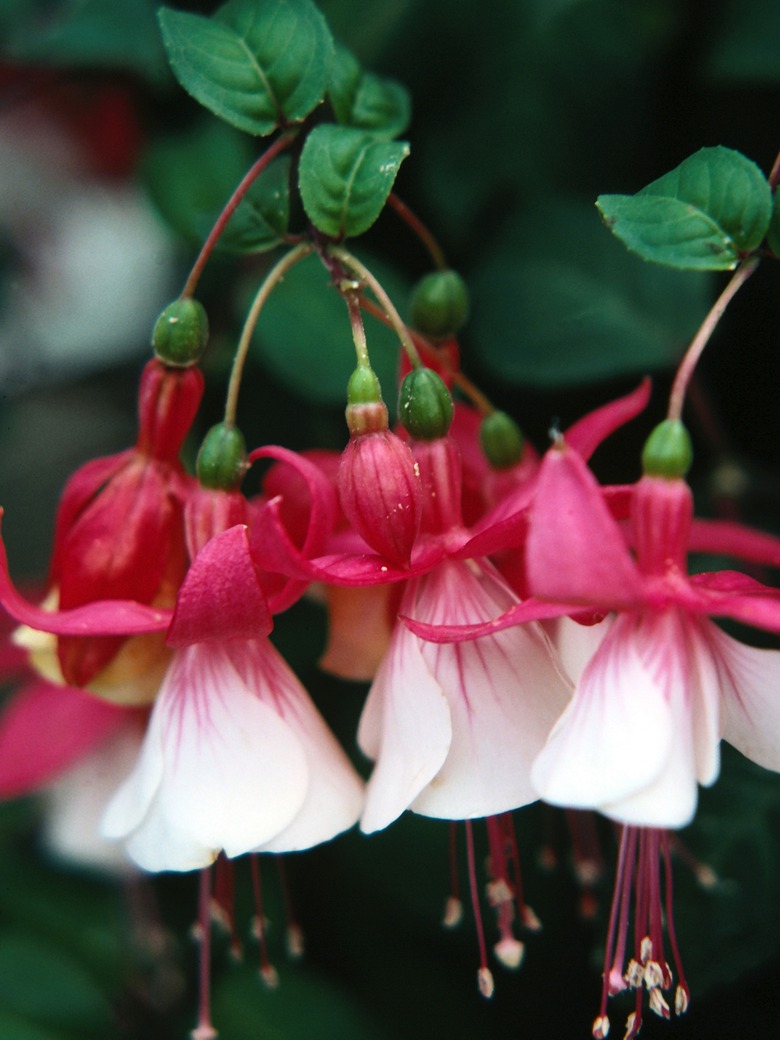What To Do For A Fuschia Plant That Is Losing Leaves
Fuchsias (Fuchsia spp.) put on quite the colorful show from summer through fall. They can also be endlessly entertaining for the kids, who will squeeze the buds to hear the popping sound they make. Typically grown in baskets that allow the trailing flower tendrils to spill over the edges, the plant can be grown in the ground in U.S. Department of Agriculture Plant hardiness zones 8 through 10, although some species are considered hardy to zone 7. All fuchsia species shed leaves occasionally over the course of the growing season. When the leaf drop is severe, it typically has something to do with the plant's growing environment, cultural care, pests or disease.
Light and Water
Step 1
Anything that puts the fuchsia under stress may cause it to lose leaves, according to the American Fuchsia Society. Inadequate light and improper watering are two stress factors. Fuchsias are healthiest when they are grown in filtered or dappled sun, especially during hot weather. Too much sun can scald the leaves and wilt the plant. If it becomes too stressed, it will begin dropping buds and leaves. Incorrect watering, such as watering the fuchsia heavily after the soil has completely dried, may cause the plant to drop leaves. Keep the soil consistently moist at all times and never allow it to dry out completely.
- put on quite the colorful show from summer through fall.
- Anything that puts the fuchsia under stress may cause it to lose leaves, according to the American Fuchsia Society.
Humidity and Temperature
Step 1
Fuchsias don't deal with heat very well, especially when the humidity level is low. Ideal temperatures range from 50 to 80 degrees Fahrenheit with humidity, especially on hot days, above 20 percent. When temperatures exceed 80 degrees the plant, in its efforts to conserve water, shuts down and begins dropping leaves and flowers. If you grow your fuchsia in baskets, place them on moist soil on the ground where they will get more humidity. Misting them with the hose also helps provide moisture and cools the air. Fuchsias will also drop their leaves when a sudden change in temperature occurs, such as moving the plant from indoors to outdoors. This type of leaf drop happens quickly and requires moving the plant back to its original location.
- Fuchsias don't deal with heat very well, especially when the humidity level is low.
- When temperatures exceed 80 degrees the plant, in its efforts to conserve water, shuts down and begins dropping leaves and flowers.
Pests
Step 1
High populations of aphids (Aphis spp.) and red spider mites (Tetranychus urticae) may cause the fuschia to drop leaves. Control these pests by spraying the fuchsia with insecticidal soap. Pre-mixed insecticidal soaps in spray bottles are available at gardening centers, hardware stores and even some supermarkets. The key to success in using the spray is to ensure that it lands on and covers the insects completely. These sprays are safe to use around pets and children.
Nutrients
Step 1
If the fuchsia's leaves turned yellow at the margins before falling from the plant, suspect a magnesium deficiency. More common in some regions than others, magnesium deficiencies, if not treated, may lead to the death of the fuchsia. It is easily treated by drenching the soil around the plant's roots with a solution containing 1 tablespoon of Epsom salt in 1 gallon of water.
- High populations of aphids (Aphis spp.)
- More common in some regions than others, magnesium deficiencies, if not treated, may lead to the death of the fuchsia.
Disease
Step 1
Fuchsia rust, a disease caused by a fungal pathogen (Pucciniastrum epilobii), causes leaf discoloration and leaf drop, if not treated. Initial symptoms include yellow splotches on the upper surface of the fuchsia's leaves and orange, powdery spots on the lower leaf surface. Not only will the plant suffer leaf drop if rust is left untreated, but branch die-back and death may result. Prevent fuchsia rust by watering the plant at the soil and not overhead, and keep the soil around the plant free of debris. Prune out infected plant parts immediately. Sterilize the pruning shears both before and after pruning by soaking them for five minutes in a solution containing 1 part household bleach to 3 parts water.
References
- University of Vermont: Fuchsia
- American Fuchsia Society: Fuchsia Problem Solving
- American Fuchsia Society: Learning Fuchsia Culture
- British Fuchsia Society: Yellow Leaves
- UC IPM Online: Aphids
- Purdue Extension: Spider Mites on Ornamentals
- Lancaster, Morecambe & District Fuchsia Society: Fuchsia Questions and Answers
- UC IPM Online: Rusts
- Royal Horticultural Society: Fuchsia Rust
